Onychomycosis(Nail fungus) is a damage to the fungal infection of the nails and its surrounding structures: nail rollers, matrix (nail sprouts) and nail bed.It is manifested by deformation and thickening of the nails, a change in their colors - the nails turn white or yellow.
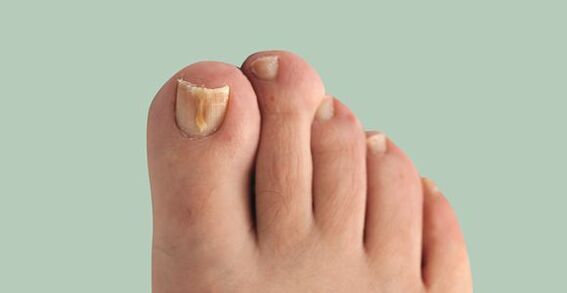
This disease is often found.The spread of onychomycosis in Europeans, according to some reports, reaches 10-12 %, exceeding the known indicators of the previous decade.In men, it is 1.5 times more common, but they are associated with the doctor twice as rarely than women.Older people get sick more often, children are very rare.
The main problem with the treatment of the disease is that patients come to see a dermatologist for a long time after the onset of the first symptoms.Therefore, the pathological fungus captures a large area and the treatment slows down.
Pathogenic mushrooms can only be transmitted by a sick person.Very often, a fungus infection occurs inside the family, as the source is not detected on time and no adequate preventive measures are carried out.
Causes of the disease:Most often, direct contact with the patient or the objects he uses (shoes, clothes, carpets in the bathroom, cloth, manicure consumables).Often the infection occurs when visiting gyms, baths, saunas and pools.
The development of the disease is facilitated by micro -versions - cracks in interdigital folds that appear due to dullness, increased sweating, dry skin, poor drying after water treatments and flat feet.
Nail mycosis can also occur in the presence of concomitant diseases of the endocrine system (diabetes, obesity, hypothyroidism), vascular diseases of the limbs (venous deficiency, lymphostasis), immune disorders, and when used antibiotics, corticosteroids and cytostatic drugs.As a result of the above diseases, the microcirculation of the blood in the nail area is impaired and the natural immunity is reduced, which contributes to the development of secondary infection.
Onychomycosis causes the following types of mushrooms:
- dermatophyte;
- yeast -similar mushrooms of the genus Candida;
- shapes
Depending on the type of pathogen, the penetration of a fungal infection and the clinical picture are different, so the approaches to therapy are also different.
The toenails are affected by a fungus 10 times more often than by hand.In most cases, dermatophytes cause the fungus (such as the trichophyte rubler).Other cases are most often caused by inconsistent forms (Aspergillus, Scopulariopsis, Fusarium).
If similar symptoms are found, consult a doctor.Don't be aware - it's dangerous to your health!
Symptoms of onychomycosis (nail fungus)
The longer the disease takes place, the more pronounced its symptoms become.The main signs of onychomycosis include:
- Digromia - a change in the color of the nail to yellow, black, green, gray or brown (the type of color depends on the type of sponge);
- Onycholysis - separation of nails from the box;
- change in nail thickness;
- Gapalonichia - the force of the thickness of the plate and its softening;
- Koylonichia - the nail looks concave, in the form of a teaspoon;
- Pahionichia - nail thickening, nail hypertrophy;
- Onichogrosis - thickening, change in the color of the nails, bent in the form of a beak;
- Change in the thickness of the nail (hyperkeratosis - thickening of the nails);
- Changing the surface of the nails: pits, grooves, combs;
- Changing nail rollers and surrounding skin (Paronychy - inflammation of the proximal nail roller).
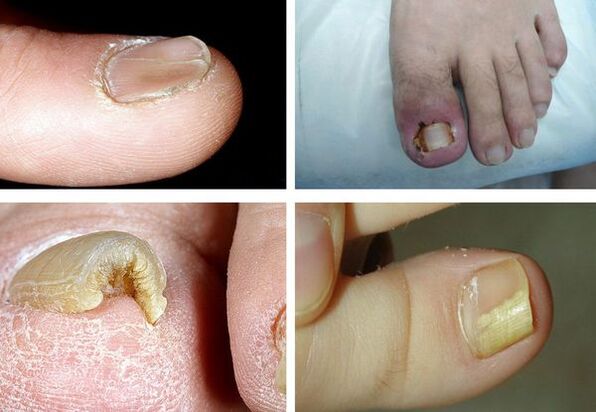
It is important to note that none of the symptoms are pathogenic, that is, unequivocally suitable for a particular pathogen, so it is impossible to determine by symptoms - additional examinations are needed.
Pathogenesis of onychomycosis (nail fungus)
The pathogenesis of the disease depends on how the fungus hits the skin and nails.
Distal type submarine:If the fungus is introduced through the skin in the nail or distal area, then the spread of the infection occurs through the free edge of the nail in the bed and further to the matrix.At first the nail plate may not change, but later, due to hyperkeratosis, it gradually deviates from the nails and becomes yellowish.Gradually, nail thickening is possible.
Surface white type:If the whitish foci are formed on the surface of the nail, then over time the fungus of the whole nails appears.The nails thicken, decay, acquire a gray-brown shade.In this case, the matrix and epithelium of the nails are not affected.There is no inflammation of the surrounding skin.
Proximal type under -heroes:The fungus can spread from the skin and the sealing rollers to the nails and then to the matrix, reaching the distal parts of the nails.Spots appear on the nail in the hole and nail, the nail plate is separated.There is no pronounced inflammation of the nails or matrix.
Total dystrophic type:The whole nail is affected.The proximal areas of the nail roll disappear or thicken so that the nail plate can no longer form and grow.
ExistThe biophysical concept of the pathogenesis of onychomycosis, which is stated that the disease has a confrontation between the two forces: a fungal colony growing in the direction of the matrix, and the natural growth of the nail from the matrix to the distal edge.Therefore, the rate of nail growth is crucial during onychomycosis -the quickly the nail grows, the earlier the treatment comes.Perhaps this is what explains the small spread of the disease in children, as their nails grow faster than in the elderly and the elderly.
Classification and stages of the development of onychomycosis (nail fungus)
There is the following classification of onychomycosis:
- Distal submarine;
- surface white;
- proximal floor;
- General dystrophic.
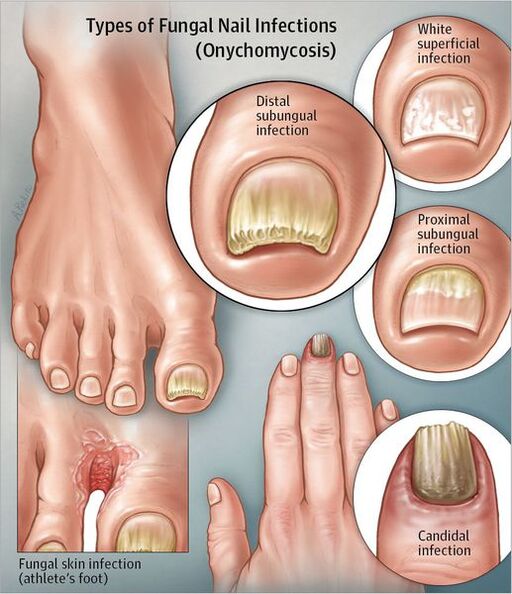
According to the 1970 classification:
- Normal: In the thickness of the nail, a ribbon of yellowish and whitish color, but the shape of the nails does not change, there is no submarine hyperkeratosis;
- Hypertroof:Nails turn yellow, thickened due to the hyperkeratosis of the submarine, becomes a fracture, with serrated edges;
- dystrophic:There is a thinning and removal of the nail plate from the nail with the formation of gaps.
Complications of onychomycosis (nail fungus)
With the long existing onychomycosis, the risk of development is increaseddiabetic foot(formation of trophic leg ulcers) andgangrene, if the patient has diabetes or vascular diseases of the lower limbs.
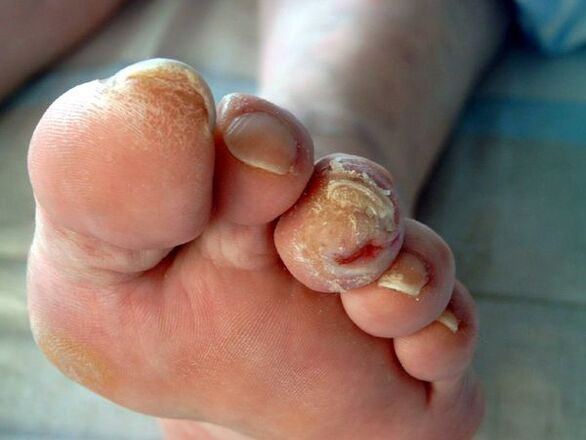
In immunosuppressive conditions (primary and secondary immunodemphals), mushrooms can spread to the skin, internal organs and cause allergies to the body.This can be manifested through skin rashes to the development of bronchial asthma.
Diagnosis of onychomycosis (nail fungus)
Before disassembling the methods of diagnosing onychomycosis, it is necessary to explain how to properly assemble the study material (the patient does it independently or prepare the nails before diagnosis).Before the fence of the study material, it is necessary to treat nails with 70 % alcohol so that there is no obstacle to other bacteria.
The material collection method varies depending on the form of onychomycosis:
- Superficial- Screw from the nails;
- Distant shape- Scratch from the nail and a piece of nails is required;
- Proximal submarine- The material is extracted from a workout or a nail biopsy is performed, or the nail scraping.
The fastest method of determining pathological mushrooms in the nail isMicroscopySTechnique: Study material is treated with alkali solution to dissolve keratin.To improve mushrooms, the ink is added to the alkali.Next, examine the resulting medicine under a microscope.
This method of research is the fastest and most objective.The sensitivity is up to 80 %.The disadvantages of the method include the fact that when you use it, it is impossible to determine the type of pathogen.
Bacteriological sowing: is an additional method for diagnosing onychomycosis.The material is sown in a special environment and interprets the result under a microscope after 2-3 weeks.This method allows you to identify the type of pathogen - this helps to determine the treatment tactics and in the choice of medicines by sensitivity.But the disadvantage of the study is that it takes a long time and its sensitivity is only 30-50 %.
Biopsy: With the help of scalpel and the use of anesthesia, the nail and the nail are cut.The material is immersed in a formaldehyde solution and is sent for histological examination in the laboratory.The advantages of this method are highly sensitive and allow you to determine the presence of a pathological fungus in the material.
Cons: It is impossible to identify the pathogen, as well as to determine the viability of microorganisms, the high cost and complexity of the method.
Geniagnostics: Molecular biological examination (PCR).This is one of the new and highly sensitive methods for the diagnosis of onychomycosis with the help of it, the pathogen DNA is revealed.It is recommended to introduce this type of diagnosis in those medical institutions that have PCR laboratories, but currently test systems for identifying dermatophytes and mushrooms of molds plan to introduce only in the laboratory.The method allows you to determine the type of pathogen, and its sensitivity is 80-90 %.Cons - high price, inaccessibility, lack of technological standards and complexity of implementation.
More and more doctors are being put into practiceDermatoscopySUsing this method, you can evaluate a change in the color and structure of the nail, the condition of the surrounding structures.Dermatoscopic examination allows you to more accurately evaluate the depth of nail damage and more correctly calculate the severity index of onychomycosis.
Treatment of onychomycosis (nail fungus)
There are several types of treatment for onychomycosis:
- Local therapy.
- Systemic therapy.
- Combined therapy.
- Correction therapy.
Local therapyIt involves the use of medicines on nails and nail rollers.Indications for local therapy:
- Limited form of nail damage.
- There are contraindications to the appointment of systemic drugs: hypersensitivity, liver disease, kidney function, pregnancy, lactation.
The advantages of this therapy are that high concentrations of a therapeutic agent are formed on the surface of the nail, which does not penetrate the bloodstream.There are no side effects of the use of antifungal drugs - nausea, decreased appetite, abdominal pain.The disadvantage of the method is that the medicinal substance does not always fall into the habitat of the pathogen, especially if the mushrooms are located in the nails or matrix.This, in turn, can lead to ineffective treatment.This type of treatment is a long time, because before the medicine is administered, it is necessary to remove the affected part of the nail.
Ways to remove the affected nails:
- Mechanically removing with files, grains or workout.
- With the help of keratolithic plasters.Before applying a keratolithic patch, the skin around the nail is sealed with a patch, a plastic mass (salicylic acid) is applied on top and sealed with adhesive plaster.The patch mass changes every 2-3 days.After each removal, the affected part of the nail is removed mechanically.
- Surgical.This surgery is very painful and traumatic, as the nail removal can be damaged, leading to the growth of deformed nails.
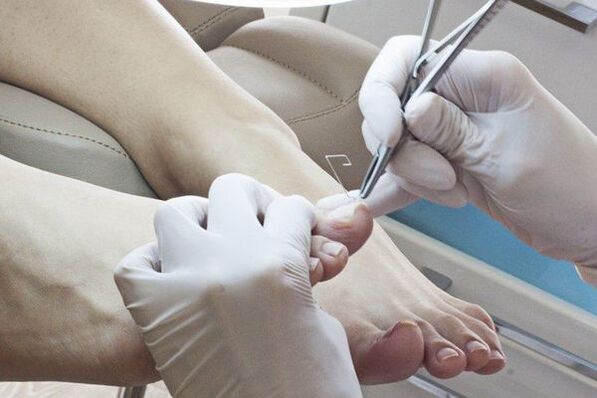
Local antifungal agents are used after removing the affected nails.AntifungalDistribute the place of application:
- It is applied to the nail: varnishes;
- Apply to rollers: creams, ointments, solutions.
The most learned tool for topical use is the 1 % solution of the drug of Alllamin Group, which has an evidence base for treatment based on Cocranny meta-analysis.This instrument has a water base that contributes to the better penetration of an antifungal substance into the place of destruction.The varnishes have a dehydrated base, which reduces the penetration of the drug into deep layers.Therefore, dermatologists consider the use of lacquers unsatisfactory and increasingly prefer a water -based tool.
In order to obtain the result of local therapy, it is necessary to monitor the treatment regimen, it is important that the patient be responsible, consistent and the patient.The duration of therapy can reach 12 months.
Systemic therapyAllows the antifungal medicine to penetrate the blood into the lesion, even if the nail and the matrix are affected.The high concentration of the drug remains in the lesion for a long time after the end of use.The disadvantages of this type of treatment are related to the risk of side and toxic effects.
Systemic therapy indications:
- General forms of nail damage.
- The lack of the effect of topical therapy (that is, after six months of treatment of onychomycosis on the hands and 9-12 months of treatment of onychomycosis of the legs, there was no cultivation of healthy nails).
A clinical severity index of onychomycosis is used to determine the treatment tactics.It is used as a therapeutic standard in different countries around the world.
MedicationFor the treatment of onychomycosis you can classify as follows:
- Antifungal - have an antifungal effect;
- Antiseptics - have both antifungal and antibacterial effects.They are rarely used only if there are no other antifungal agents;
- Multi -Component - In addition to antifungal agent, they contain other medicines such as anti -inflammatory agent.
Medicine medicine:
- standard - daily administration of medicines during the prescribed treatment period;
- shortened - the treatment period is shortened, can be performed by conventional doses or extended;
- Discontinuation - treatment is prescribed in several short courses, the intervals between the courses are equal to the duration of the courses;
- Pulse therapy is prescribed in several short courses, the intervals between the courses are higher than the duration of the courses.
Antifungal drugs are divided into an active substance:
- Triosols;
- Alullamins;
- Morpholins.
System therapy is currently being usedThird generation only medicinesS
Combined therapyLocal and systemic treatment are performed at the same time.Combination therapy is used if it is necessary to increase the effectiveness of systemic therapy and reduce treatment periods.
Correction therapy(Treatment of concomitant diseases): In order to choose a treatment regimen, it is necessary to evaluate the general somatic condition of the body.Diseases such as blood circulation in the limbs can reduce the access of the antifungal agent to the lesion.Therefore, medicines that improve tissue trophic are prescribed.
Due to the toxic effects of systemic antifungal drugs, it is necessary to exclude liver disease and, if necessary, to prescribe hepatoprotectors.
Forecast.Prevention
The earlier the patient contacts the doctor with signs of fungal nail lesions, the more the disease will be cured and restore the nail plate.With long existing processes with capturing the entire nail, the treatment of onychomycosis can be long, but with all recommendations, recovery often occurs.If there are contraindications to systemic therapy, long -term maintenance treatment with local drugs is required.
PreventionIt is necessary to observe the rules of personal hygiene and to reduce the possibility of re -infection:
- Try to wear comfortable and high quality shoes (to prevent increased sweating);
- It is recommended that you change socks and tights daily;
- Use only individual shoes.Those who undergo onychomycosis should be treated at the beginning of treatment, at least once a month throughout the treatment period and after its end;
- If necessary, use antiperspirants for the legs;
- Use an individual nail care set (scissors, saws);
- Before and after visiting public places (swimming pool, bathroom, sports hall), use antifungal outdoor products (sprays, cream and pencils);
- To identify the source of fungal infection in the family and to cure at the same time.
It is recommended that an antifungal processing of personal belongings, shoes, bathrooms, floors and carpets be performed periodically.For these purposes, you can use 40 % acetic acid solution, 1 % alcoholic solution of antiseptic (prescribed by a doctor), solutions for disinfection.The underwear can be boiled in 1-2 % of the soap-lainer solution for 20-30 minutes, ironing at maximum temperature.


















